#asteriornis
Text
Fossil Novembirb: Day 1 - The Chosen Ones
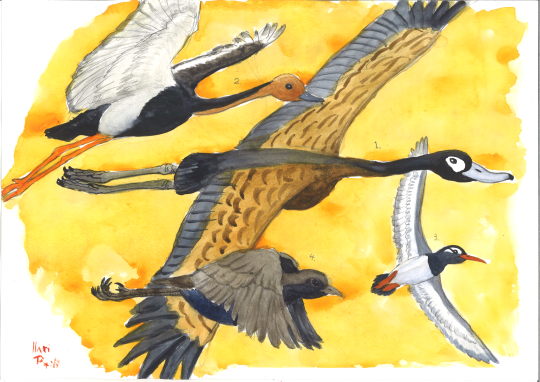
All the dinosaurs died out at the end of the Cretaceous during the K/Pg extinction event 66 million years ago. All of them? No! One group of dinosaurs managed to survive the event and are still around today. Neornithes, or Crown birds. They evolved during the end of the Cretaceous period, and by coincidence, had traits tohelp them survive the cataclysm. Here's a few of these early feathered friends.
Teviornis, a large wading Presbyornithid (flamingo-duck) from Mongolia
"Styginetta", a smaller Presbyornithid (flamingo duck) known from Western North America
Vegavis, a strange, small diving seabird related to ducks and geese, known from Antarctica
Asteriornis, sometimes called the "wonder-chicken", a tiny long legged shorebird related to the common ancestors of ducks and chickens, known from Belgium
#Fossil Novembirb#Novembird#Dinovember#birblr#palaeoblr#birds#dinosaurs#Cenozoic Birds#teviornis#styginetta#vegavis#asteriornis
206 notes
·
View notes
Text
Asteriornis sketch for the first day of fossil novembirb! I don’t know if I’ll be able to keep up with something every day, but it’ll be fun to try

#fossil novembirb#asteriornis#I was kind of imagining it as halfway between a chicken and a killdeer#but also not like exactly like either of those#eeeehhhh now that I’m looking at it I think I made the head way too big#this is probably generally not right but an attempt was made
78 notes
·
View notes
Text
Round Two: Vorombe vs Asteriornis
Vorombe titan

Artwork by @otussketching, written by @zygodactylus
Name Meaning: Titan of the Big Birds
Time: 10,000 years ago to sometime in the past 2000 years (Holocene epoch of the Quaternary period)
Location: Southern Madagascar
Vorombe is a newly erected genus of Elephant Bird, the largest that we know of! Whereas all species of Elephant Bird used to be put in the same genus, distinct differences among the types of Elephant Bird that we know of indicate they deserve their own genus names - and here we are! Vorombe was significantly larger than the other species of Elephant Bird, and probably was about 3 meters (nearly 10 feet) tall when standing. It was also ridiculously heavy, weighing around 650 kilograms. As such, Vorombe is currently the largest known bird ever recorded. It lived in the arid and succulent woodlands as well as the grassland mosaics, the weirdly unique habitats that charactierize Madagascar, and was a major feature in the functioning of those ecosystem - helping to spread plant seeds and maintain habitats as they lived within them. Vorombe and other Elephant Birds lived alongside a lot of weird animals during the Quaternary of Madadgascar, including dwarf hippos, giant tortoises, and giant lemurs.
Note: A paper came out literally on the last day of February this year indicating Vorombe may not be its own genus. More work is needed to determine if this bird is distinct from Aepyornis.
Asteriornis maastrichtensis

Artwork by @otussketching, written by @zygodactylus
Name Meaning: Asteria’s Maastrichtian Bird
Time: 66.8 million years ago (Maastrichtian stage of the Late Cretaceous_
Location: Maastricht Formation, Eben-Emael, Belgium
Say hello to the Wonderchicken! While we know that modern dinosaurs - birds - had to have evolved in the Mesozoic, and diversified somewhat during it, actual fossil representatives of Mesozoic modern birds are quite rare, with only a few duck-related taxa (Vegavis and Teviornis) known. Asteriornis finally adds a stem-chicken to that group, which we knew had to have been around since we had stem-ducks! (They diverged at the same time, so the presence of stem-ducks requires the presence of stem-chickens). A small, long-legged bird, Asteriornis had a lot of characteristics similar to both chickens and ducks, indicating it may have evolved right after that initial divergence. It had a slightly down-curved beak without specializations, allowing it to have a generalist diet. It had wings similar to living ground birds, and that combined with its long legs indicates a terrestrial lifestyle. Living along the coast, Asteriornis would have eaten whatever it could forage for, possibly wading into the water or trekking through high vegetation when necessary. It lived near the ocean, along the coast, and as such it shared its habitat with many types of invertebrates, including corals and echinoderms and crustaceans, as well as ammonites. Surrounded by grasses, palms, and shrubs, Asteriornis also lived alongside other vertebrates such as a wide variety of sharks, tons of mosasaurs, turtles, elasmosaurs, marsupials, and other dinosaurs such as Orthomerus, Janavis, large theropods, an unknown opposite-bird, and other potential Ornithurans.
#dmm#dinosaur march madness#dinosaurs#birds#dmm rising stars#dmm round two#birblr#palaeoblr#paleontology#bracket#march madness#polls#vorombe#asteriornis
135 notes
·
View notes
Text
Modern-type birds share several key traits, such as toothless beaks and fused foot bones. The almost 11,000 living bird species — the paleognaths (flightless birds such as ostriches), anseriformes (waterfowl), galliformes (land fowl) and neoaves (the remaining 95 percent of living bird species) — all share a common ancestor, Field says. “We think that ancestor lived at some time before the end of the Age of Dinosaurs,” he says. But there are very few bird fossils surviving from before the asteroid impact.
3 notes
·
View notes
Text
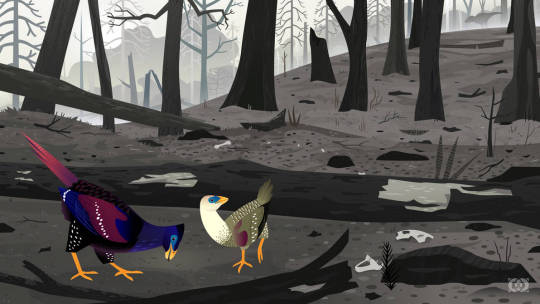
In the ash and devastation of a burned forest in the Hell Creek ecosystem, a pair of stem-fowl, inspired by Asteriornis, scavenge seeds. In the background, a T. rex wanders in search of carrion.
Since I love including turtles in my paleoart, the remains of a Basilemys are scattered among a dry creekbed.
There are no animals like these stem-fowl known from the Hell Creek formation, but they very well could have lived there.
The original concept for this was as a post-asteroid scene. Then I learned about the heat pulse in Riley Black's "Last Days of the Dinosaurs." And it didn't seem so plausible any longer. So now it's a simple scene in the aftermath of a forest fire!
#illustration#paleoart#paleontology#natural history#science#dinosaurs#sciart#vector illustration#vectorart
1K notes
·
View notes
Text
Seems we'll be getting a paleontology documentary on the evolution of birds. Not much is confirmed so far other than that it will be 2 hours long, deal with the survival of birds through KPG and the evolution of flight and explicitly tackle Asteriornis from Hell Creek and apparently Pleistocene Denmark.
108 notes
·
View notes
Text
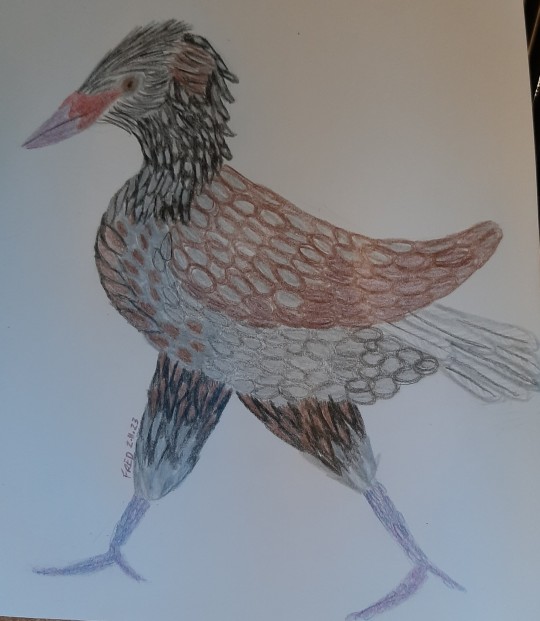
My attempt at Asteriornis. She's modelled in colour after my hen, a very pretty Aracauna by the name of Elaphrosaur.
I'm in the southern hemisphere, so I'm technically on day two of Fossil Novembird, but I'm doing day one first anyway!
#fossil novembirb#arting is not really my strong point#but i do love the dinosaurs#so I'm going to try
10 notes
·
View notes
Text
While the Prehistoric Planet hype is still alive, I might as well express my desire for more and say what I'd personally love to see if they did a Season 3. I’ll put this under the cut because it’s a lot lol.
First thing's first, I'm going to be operating under the assumption we will be following the same format and setting, ie a few segments per episode set in the Masstrichtian stage of the Cretaceous with some loose overarching theme. I need to keep myself grounded in SOMETHING.
So first thing: I've already made fun of "North America" being the title of episode 2.5. What would fix this? If Season 3 did episodes centred on the other continents, of course! South America, Africa, Asia, Europe and... oh uh this might be a bit trickier. Specifically, where do Oceania and Antarctica go? Honestly, just do a vague "East Gondwana" episode for Madagascar, India, Antarctica and Zealandia.
"But we never saw anything from Appalachia!" True. Some generic "Islands 2" or "subcontinents" episode? But Antarctica isn't a subcontinent... maybe some "Atlantic" episode to combine with the European islands? Point is, it would still be messy. This isn't even my main idea, just a vague thought on how to structure Season 3 plus being salty that America gets its own episode (there weren't even any Canadian creatures lol).
OKAY enough fucking around, let's get to what I actually WANT to talk about, the stuff I'd actually want to see. Bring on the list!
Megaraptorids. We've seen representatives of all the large predatory theropods... except megaraptorids. A strange unique group of predators we don't even know where they fit in dinosaur cladistics, but seemed to be important in South American ecosystems. Orkoraptor actually comes from the same place as Dreadnoughtus so there's an easy excuse already, but I think it would be even more exciting to consider Maip. The size of this thing pretty much confirms they were apex predators, so definitely worth considering.
More notosuchians. It's wild how diverse they were, Simosuchus is just one of many species worth showing. Might as well mention Baurusuchids in particular, especially since they seem to have become significant predators in parts of South America. Dinosaur hunting crocs, guys.
Honestly? I'm down for crocodyliformes in general. Show us dyrosaurs in the seas, and even Eusuchians. Similar to modern crocs like Shamosuchus in Swamps, or something different like the more terrestrial Allodaposuchus.
More Europe weirdness! Whether it be Hateg fauna or stuff we know from other parts of the continent, I think people don't realise how unusual those ecosystems were, especially compared to Laurasia in general. Maybe I just want to see Magyarosaurus in detail, but also think about how Abelisaurs seem to be prominent terrestrial predators, for example? Also all the strange birds like Gargantuavis and maybe Balaur. Also, Asteriornis I see a lot of hype for. ;P
On a similar note, more stuff from Africa could be nice, especially terrestrial fauna! We know dinosaurs from Ouled Abdoun, which had fauna featured in Coasts and Deserts, and it's worth considering especially because you kind of see how some of these animals' ancestors may have led to similar species in nearby Europe. Also, if they ever further described more remains from the continent like that giant Kenyan abelisaur, that could provide cool opportunities.
This is a bit more out of left field but: non-ceratopsid ceratopsians. Leptoceratopsids, and even Protoceratopsids (hey, we have Velociraptor, we can make that stretch). Show how they're different from say Triceratops.
More non-hadrosaur ornithopods. Whether it be Thescelosaurus, more rhabdodontids, or some good ol Elasmarians from the Southern continents, I'd be down.
More India stuff is always fun, Deccan Traps FTW, could show other animals like noasaurs for that matter too.
Also Parankylosaurs, whether it be Stegouros with the macuahuitl, or an updated Antarctopelta (more Antarctica FTW).
Basically, even in terms of dinosaurs, show more stuff you've yet to do. Nodosaurs, Halzkaraptorines (again, see Velociraptor), heck even more of some groups we only briefly saw eg Alvarezsaurs and Pachycephalosaurs.
Honestly? More birds would be cool in general. I know we don't know much about a lot of them like Enantiornithines, but we could still try showing what we do know.
In terms of more familiar and recognisable stuff? I mean, you can't go wrong with well known species, but this is me wishing for stuff that's new. :P I will say though, if you want big names, we still haven't seen Ankylosaurus or Gallimimus...
Hmm, we haven't seen choristoderes, have we? In terms of other reptiles, not much comes to mind, nice we got to see Madtsoia in Islands at least.
Honestly more mammals could be fun. I'm pretty sure we have members of every modern group from the Maastrichtian somewhere (even monotremes, Patagorhynchus was recently described). Also diversity of lifestyles too.
Appalachia. More North America, but we see how life evolved somewhat differently on the eastern side of the continent and how it likely lacked some of the more recognisable animals we know from Laramidia.
I don't know enough about other groups to comment, so I'll leave it at that. Definitely got quite extensive, but honestly I'm all for exploring new places. Hell, look into invertebrates and fish I know heck all about (hmm I'm sure there's some cool sharks, right?).
Anyway, time to address the elephant in the room. What if the next season left the Maastrichtian, or we got a spin-off that did that? Well, I do have thoughts on that. For that, I could easily be SUPER biased and just name stuff that I personally want to see, but I think you'd need to think from the perspective of the higher ups too. In other words, what's gonna get the most eyes on the show? There's that, and also how well known the information of that time is, as well as considering things like cost and practicality. The Maastrichtian was chosen because it filled all three of those needs. You have iconic and charismatic species like T. rex, the Maastrichtian is very well studied and has sites from almost every continent, and because it's the closest to today, it's the easiest to film for.
I don't really know anything that would fit these three needs perfectly, ESPECIALLY in terms of filming locations (unless they wanna go majority CG, which I wouldn't mind personally but I know the production team likes real locations because of what they add to the show). But anyway, I have two possible eras as my main choices if they choose to do a similar kind of show: the Late Jurassic epoch (I'd name a specific stage but I don't know enough about them lol), and the Cenomanian stage at the start of the Late Cretaceous.
For the Late Jurassic (insert chosen stage of it here), you have a lot to work with. You have all the other most iconic traditional staple dinosaurs like Stegosaurus, Brontosaurus, Brachiosaurus and well known contemporaries like Diplodocus, Allosaurus, etc. In fact, the Morrison Formation is the main reason I opted for a Late Jurassic option. Sure, it does cover quite a bit of time, but we've seen Prehistoric Planet already take liberties with a six million year time span.
I think my main worry would be that some of the ecosystems on different continents might seem a bit similar, but honestly I doubt anyone would care too much. Plus, you have Asia with slightly different dinosaur groups, and Europe with their island ecosystems (eg Solnhofen). So even if it would be harder to film and some of the best locales for data are in more concentrated areas, I think there's enough to justify it. Also, novelty of early birds and birdlike dinos like Archaeopteryx.
As for the Cenomanian, you already have an easier time filming because angiosperms are now widespread, and you do have data from every continent. And while it doesn't have so many iconic species, there are a few, and some very charismatic animals to explore. Like, you have some of the biggest titanosaurs like Argentinosaurus. Massive Giganotosaurins who are built for hunting large sauropods. Everyone's favourite dinosaur, Spinosaurus. And again, stuff from almost every continent. Like, you could even have freaking Australia show up! Winton Formation is Cenomanian, so it could join the showcases of Africa, South America and others (I don't know so much about Cenomanian Laurasian fauna RIP). And while it would be true for the Late Jurassic as well, this time had especially peculiar nondinosaurs coexisting. Strange mammals. Giant freshwater fish. More unusual crocs. Even the earliest mosasaurs, all while ichthyosaurs and pliosaurs still existed. Basically, even if a layperson might only know Spinosaurus and Giganotosaurus from this time, you still have loads to potentially awe people with.
Anyway, that's a wrap on that. I have no clue what to expect for the future of Prehistoric Planet or what other upcoming palaeo docs will be like, but it's always fun to speculate!
16 notes
·
View notes
Text

A life restoration of Asteriornis I made for Wikipedia.
File on Wikimedia
#dinosaur#dino#dinosaur art#dinosauria#theropod#theropoda#feathered dinosaurs#bird#bird art#cretaceous#late night#paleoart#paleontology#paleoillustration#palaeoart#palaeontology#palaeography#fossils#extinct birds#birds#dinosaurs
121 notes
·
View notes
Photo
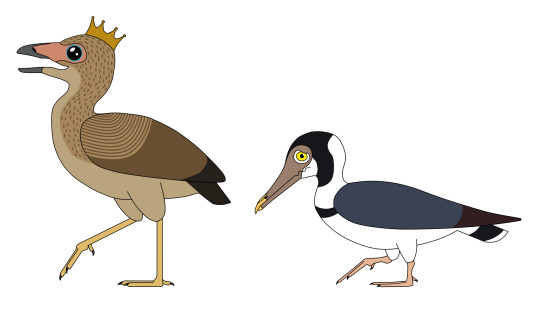
I was conscripted by my labmate Lizzy Steell into designing these characters for the Cambridge Department of Earth Sciences' music video about Asteriornis, our entry in the Palaeovision contest held at the Palaeontological Association meeting in 2021. We didn't win.
31 notes
·
View notes
Text
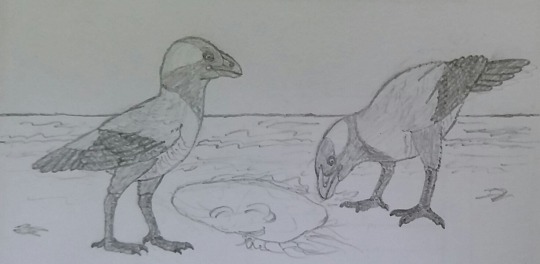
Pair of Asteriornis with beached jellyfish.
4 notes
·
View notes
Text
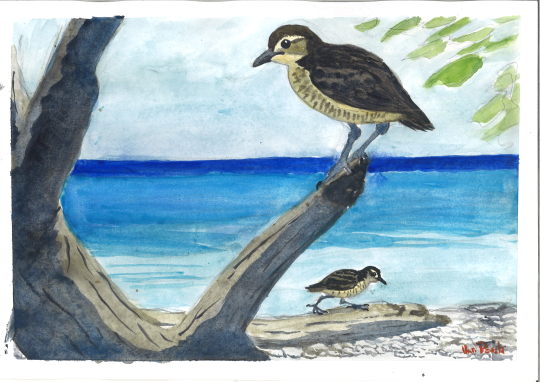
A pair of Asteriornis foraging on a tropical beach in Belgium, 66 million years ago.
Asteriornis maastrichtiensis is one of the oldest modern birds that we know of, living at the very end of the age of the dinosaurs. It was a galloanserine, meaning that it was related to ducks, geese, grouse, turkeys, megapodes, and other gamefowl.
Despite being a galloanserine, Asteriornis seems to have been similar in ecology and bodyform to a shorebird, which comb beaches today for food. So, I decided to base this particular reconstruction on some tropical sandpipers, namely the Tuamotu sandpiper (Prosobonia parvirostris) and Bristle-thighed curlew (Numenius tahitiensis), both of which dwell in the beaches of French Polynesia. At the time, Belgium migh have been just as warm.
243 notes
·
View notes
Photo

#Asteriornis - Fotomanipulación rápida / Quick photomanipulation #wonderchicken #quarendino https://www.instagram.com/p/B-ucj0El9yH/?igshid=fni1llidx94u
6 notes
·
View notes
Text
Asteriornis vs Panraogallus
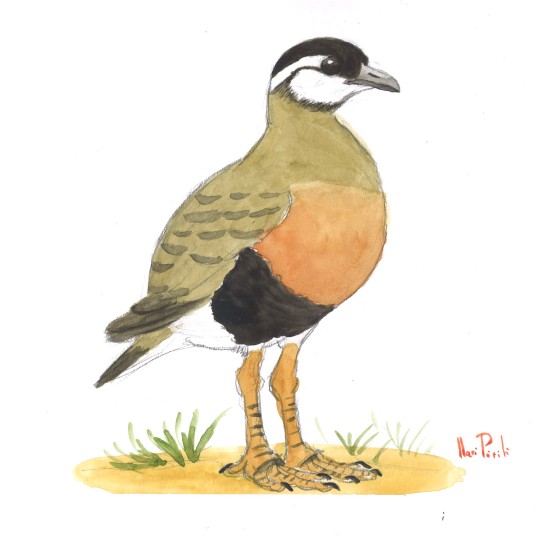

Factfiles:
Asteriornis maastrichtensis

Artwork by @otussketching, written by @zygodactylus
Name Meaning: Asteria’s Maastrichtian Bird
Time: 66.8 million years ago (Maastrichtian stage of the Late Cretaceous_
Location: Maastricht Formation, Eben-Emael, Belgium
Say hello to the Wonderchicken! While we know that modern dinosaurs - birds - had to have evolved in the Mesozoic, and diversified somewhat during it, actual fossil representatives of Mesozoic modern birds are quite rare, with only a few duck-related taxa (Vegavis and Teviornis) known. Asteriornis finally adds a stem-chicken to that group, which we knew had to have been around since we had stem-ducks! (They diverged at the same time, so the presence of stem-ducks requires the presence of stem-chickens). A small, long-legged bird, Asteriornis had a lot of characteristics similar to both chickens and ducks, indicating it may have evolved right after that initial divergence. It had a slightly down-curved beak without specializations, allowing it to have a generalist diet. It had wings similar to living ground birds, and that combined with its long legs indicates a terrestrial lifestyle. Living along the coast, Asteriornis would have eaten whatever it could forage for, possibly wading into the water or trekking through high vegetation when necessary. It lived near the ocean, along the coast, and as such it shared its habitat with many types of invertebrates, including corals and echinoderms and crustaceans, as well as ammonites. Surrounded by grasses, palms, and shrubs, Asteriornis also lived alongside other vertebrates such as a wide variety of sharks, tons of mosasaurs, turtles, elasmosaurs, marsupials, and other dinosaurs such as Orthomerus, Janavis, large theropods, an unknown opposite-bird, and other potential Ornithurans.
Panraogallus hezhengensis

Artwork by @otussketching, written by @zygodactylus
Name Meaning: Coiled Chicken from Hezheng
Time: 7.25 to 11.1 million years old (Tortonian stage of the Miocene epoch, Neogene period)
Location: Liushu Formation, Gansu Province, China
Panraogallus was a weird early chicken that differed from others by one notable feature: a very long neck, much longer than other pheasants. This is only seen in a handful of related birds today. Panraogallus seemed to follow the zigzag pattern present in some grouse rather than a loop like that seen in a cracid or guineafowl. This gave it a low, loud call, distinct from those of other pheasants. It was quite large, around 2.5 kilograms on average. The calls of these species, which would have traveled extremely long distances in its habitat, were probably used in communication - to attract mates, warn of danger, and gather flocks. In the temperate savannah habitat, Panraogallus would have been able to reach each other over large distances, very easily coverable in single days of walking in such an open area. Other birds in the area included the diurnal hawk-owl Miosurnia, kestrels, old world vultures, ostriches, sandgrouse, and the weird Ergilornithids. Mammal neighbors included Gomphotherium, Chilotherium, Chalicotheres, weird horses, bizarre giraffids, and giant hyena mimics.
DMM Round One Masterpost
#dmm#dinosaur march madness#dinosaurs#dmm round one#dmm rising stars#palaeoblr#paleontology#bracket#march madness#polls#asteriornis#panraogallus
94 notes
·
View notes
Video
youtube
'Wonderchicken' - Discovering the world's oldest modern bird fossil
4 notes
·
View notes
Text
This is mostly just a reminder to myself if I (or anyone else if you get to it first) ever get around to drawing Rung in the Birdformers au.
He’s gonna be an asteriornis maastrichtensis, one of the oldest birds in the known fossil record.

Since the Birdformers au takes place in modern day, very, VERY few characters can be extinct birds, and even then it’ll be birds that went extinct within the last 160 years or so.
Rung is an enigma to everyone lol. He’s older than the human species, and no one knows how he’s lived for so long.
He probably doesn’t know himself, but he’s more keen on just vibing and providing any advice/helpful words and such.
#fun fact asteriornis maastrichtensis is nicknamed the wonder chicken and is the only known species in its group#which was also related to an extant group that contains chickens and ducks#text post#rung#birdformers au#asteriornis maastrichtensis
41 notes
·
View notes